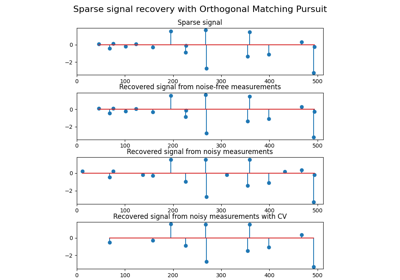make_sparse_coded_signal#
- sklearn.datasets.make_sparse_coded_signal(n_samples, *, n_components, n_features, n_nonzero_coefs, random_state=None)#
生成一个由字典元素稀疏组合而成的信号。
- 返回矩阵
Y、D和X,使得Y = XD,其中X的形状为 (n_samples, n_components),D的形状为(n_components, n_features),并且X的每一行都有恰好n_nonzero_coefs个非零元素。
更多信息请参阅 用户指南 。
- Parameters:
- n_samplesint
要生成的样本数量。
- n_componentsint
字典中的组件数量。
- n_featuresint
要生成的数据集的特征数量。
- n_nonzero_coefsint
每个样本中活跃(非零)系数的数量。
- random_stateint, RandomState 实例或 None, 默认=None
确定用于数据集创建的随机数生成。传递一个 int 以在多次函数调用中获得可重复的输出。 请参阅 术语表 。
- Returns:
- datandarray of shape (n_samples, n_features)
编码的信号 (Y)。
- dictionaryndarray of shape (n_components, n_features)
归一化组件的字典 (D)。
- codendarray of shape (n_samples, n_components)
稀疏编码,使得此矩阵的每一列恰好有 n_nonzero_coefs 个非零项 (X)。
Examples
>>> from sklearn.datasets import make_sparse_coded_signal >>> data, dictionary, code = make_sparse_coded_signal( ... n_samples=50, ... n_components=100, ... n_features=10, ... n_nonzero_coefs=4, ... random_state=0 ... ) >>> data.shape (50, 10) >>> dictionary.shape (100, 10) >>> code.shape (50, 100)
- 返回矩阵


